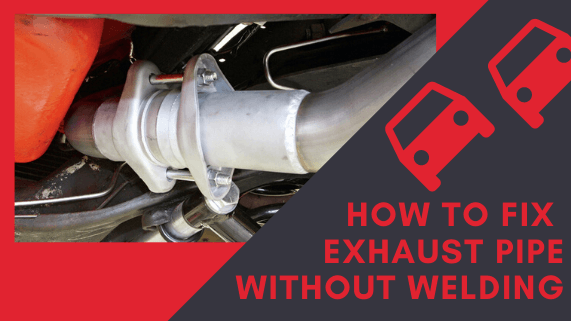As the exhaust fumes are toxic, it is hazardous to drive a car with an exhaust leak. It throws Carbon Monoxide that can’t be smell but is very poisoning. Apart from that, even your vehicle’s fuel efficiency might be dropped, and you may get a citation for causing pollution. If you don’t repair or replace the leaking pipe, it can also damage the catalytic convertor. In short, you should never take it lightly if you want to save a significant expense. Also, why take a risk when you can join the exhaust pipe quickly at home? This article will guide you on how to fix an exhaust leak without welding.
Well, to fix an exhaust pipe without welding is a simple process. However, it is crucial to have some special material that can make the process fast.
Things You Will Need
- Wheel ramps or axle stands
- Protecting goggles
- Screwdriver and Jubilee clips
- Metal snips
- Epoxy and Wooden dowel
- Pliers and Spanners
- Exhaust repair paste
- Steel-toothed brush
- Sandpaper
- Acetone or Nail polish remover
- Repair patches
Warnings:
- DO NOT trust car jack. You should never do underneath work just with a jack. It cracks or breaks sometimes and becomes a high risk.
- It is essential to have a supreme quality eye-protection to protect your eyes from rust and toxic chemicals. You can use transparent safety goggles.
- It is suggested to wear a cap, an old full-sleeve shirt, and full pants. Appropriate clothing will protect your skin from chemicals. You may also get un-removable gloop on your clothes.
- You should always look for the blacktop or concrete surfaces. To jack up a car on grass or dusty surface is very risky as it may topple the jack.
- Sometimes, the exhausting pipe takes a few hours to cool itself down. Before that, you can’t touch it as it might be too hot to handle. Do not hurry and avoid burning.
How to Fix Exhaust Pipe without Welding
Step 1: Find the Location of the Exhaust Leak
To find the problem, park the vehicle on a firm surface first. Choose a concrete surface if possible. You can also put your car on a level to repair the leak. However, it is extremely important to choose a surface that can bear the car’s weight and jack up a car safely. Once it’s done, you have to give it some time so that the exhaust pipe can cool down. You may know that if the engine is on, the exhausting tube of your vehicle might be extremely hot. So, always check before putting your hands on the pipe. To check if it is still hot, touch the hood of your car first. If you feel warmth, then give a few more hours for pipe cooling.
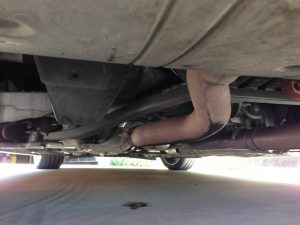
Step 2: Jack up the Car and Inspect the Exhaust Piping
The jack should be used only to get the desired height. It is not safe to work under the car that is being supported only by a jack. It is essential to place jack stands, or wheel stands beneath the vehicle to ensure safety. Once the car is up, start inspecting the exhaust piping thoroughly. If you don’t have any idea about the leaking location, then start from the front and keep examining your way back. You can expect the signs of damage such as scrapes and cracks. You can also find holes if the damage is bigger. Apart from these, rust is also a common cause of exhaust leakage. Try to find out the reason and then go further. If you are still unable to find the leakage, then you should start your vehicle to locate the leaks.
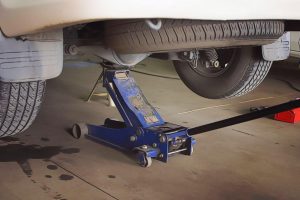
Step 3: Decide the Repair Option
Once you know the cause of the damage, you have to find the most convenient and appropriate repair option for your exhausting pipe. For example, scrapes and holes can be repaired without the cutting and welding, but if the pipe is covered in extensive rust, then there is no other option than the replacement. Even the small holes can be repaired using tape or putty. If the hole is too large to be fixed by the exhaust tape, then you will need a piece of aluminum that would be sealed with epoxy.
Step 4: Clean the Damaged Area
Get a steel-toothed brush and start scrubbing the affected areas of the vehicle’s exhaust pipe. Clean out the mud, dirt, grime, and rust particles, wearing your protective goggles. Then take sandpaper and remove the remaining bits of dirt to prepare the surface for the repairs. This process is vital to keep the metal surface ready and clean so that the patches can create a stronger bond. Once its done, use Acetone and wipe out the entire pipe. If you don’t have Acetone, then you can also use any nail polish remover to clean the surface area.
Step 5: Seal the Damaged Area
Using a Patch:
Small cracks or holes can be sealed with tape or epoxy, ut you will surely need patches if the holes are a bit larger. To apply a patch, first, you need to determine the size you will need to cover the damaged area. After that, it is important to cut the patch to match the size. Wear hand gloves if needed and cut the aluminum can to make the sealing patch. Then, apply the epoxy to the damaged area that needs to be sealed and fix the patch. Do not use more epoxy to avoid dripping into the exhaust pipe.
If you want to wrap the patch around the pipe, apply the epoxy everywhere and a bit more to the leak area. Once placing the patch over the leak, don’t forget to apply epoxy all over the patch once again. You can use a wooden dowel to apply more epoxy to the edges. Please ensure that there are be no pinhole leaks after that.
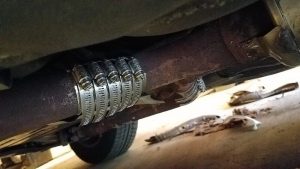
Using an Exhaust Tape:
If you have a repair tape, then the task will become easier. Firstly, cover the leak with two layers of tape and see if they have sealed the leak properly. Keep one thing in mind is that each tape has a different application method. Some can be applied on a wet surface, and some need to be used on warm surface areas. So, it is mandatory to read the instructions when you want to join an exhaust pipe without welding.
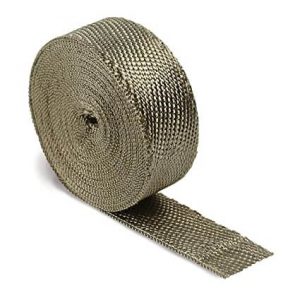
The Bottom Line
Exhaust leaks can cause many issues for car owners. If your exhaust systems are rusty, you will have to change it as soon as possible. Such defective pieces of your car may damage the whole system within no time and can also risk your life. So, make a habit of conducting regular inspections and providing your vehicle with better maintenance from time to time. You just need the right tools and techniques to ensure the safety of your car and your family that travels in that. Stay tuned with more such updates and step-by-step guides.

